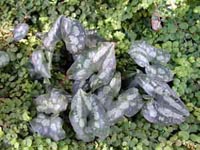Resource Library
Plant of the Week: Splendid Ginger
The University of Arkansas System Division of Agriculture does not promote, support or recommend plants featured in "Plant of the Week." Please consult your local Extension office for plants suitable for your region.
Plant of the Week
The Splendid Ginger
Latin: Asarum splendens

Two years ago, I was skulking through the isles of a local nursery when I happened upon a perennial - an ornamental ginger - that was new to me.
Unlike most wild gingers, with their cute but small leaves, this plant had large, marbled leaves that looked robust enough to compete with the weeds that sometimes creep into my woodland garden. This Asian ginger warrants a closer look.
Asarum splendens is an evergreen groundcover growing 6 to 8 inches tall with thick, leathery, lance-shaped leaves that grow about 6 inches long. The leaves are marked with large, irregular patches of silver on a green background making them the most ornamental of the 75 species of gingers so far described.
Wild gingers have a decidedly creeping form with flowers produced at ground level so that only slugs and the most observant naturalist ever notice them. In early spring, the brownish, cup-shaped flowers appear that are about the right size to slip over the end of your finger. The fat tube ends in three petals that flare out at right angles. The flowers of this species are larger than the typical wild ginger.
The low growing wild gingers shouldn’t be confused with the corn-like ornamental gingers we grow in southern gardens or to spice Chinese and Indian cuisines. Our native wild ginger (A. canadense), with its green, kidney shaped herbaceous leaves, was used extensively in native American folk medicine but not in cookery.
This ginger made its way into the United States in 1978, when Richard Howard, who directed the Arnold Arboretum in Boston at the time, was invited to visit China after the Gang of Four had been deposed, and the new premiere, Deng Xiaoping, began normalizing relations with the West.
Howard quickly realized this new ginger had potential as a garden plant because the mother plant maintained in the Arboretum greenhouse was stolen not once, but twice. Fortunately, a single division had been made and this new plant became the source material for the plants the Arboretum began sharing with nurserymen in the late 1980s. Naming the ginger has required the sacrifice of a small forest to make paper for all of the various technical names taxonomists have associated with the plant. At least four names have been used to describe the plant in its short stay in the West, but hopefully they are now agreed that A. splendens, the Splendid Ginger, is the correct choice.
The nice thing about A. splendens is that it responds well to cultivation and produces foot-long rhizomes each season. These rhizomes not only permit the plant to spread fairly rapidly (for a ginger) but they provide division material if additional plant starts are needed.
This trailing evergreen ginger is a perfect landscape plant for the suburban garden because it is low growing, has easily restrained growth and grows in the shade. It makes a dignified groundcover for the shade garden or a showy specimen amongst other diminutive perennials.
They should be planted in a well prepared organic soil that can be watered during the summer. I have seen no indication they are bothered by insect or disease problems. It seems winter hardy throughout the state and should grow as far north as St. Louis.
By: Gerald Klingaman, retired
Extension Horticulturist - Ornamentals
Extension News - August 2, 2002
The University of Arkansas System Division of Agriculture does not maintain lists of retail outlets where these plants can be purchased. Please check your local nursery or other retail outlets to ask about the availability of these plants for your growing area.